In the dynamic landscape of digital marketing, the tools at your disposal can make a significant difference in the success of your advertising campaigns. From small startups to well-established corporations, the right ad campaign management tool can streamline operations, optimize budget allocation, and enhance ad performance.
In this comprehensive guide, we dissect 21 of the most potent ad campaign management tools, offering you a detailed overview, discussing features, pros and cons, pricing, USP, and pinpointing the ideal user base for each. Armed with this information, you will be poised to make an informed decision, selecting a tool that aligns perfectly with your business objectives and needs.
#1. Google Ads
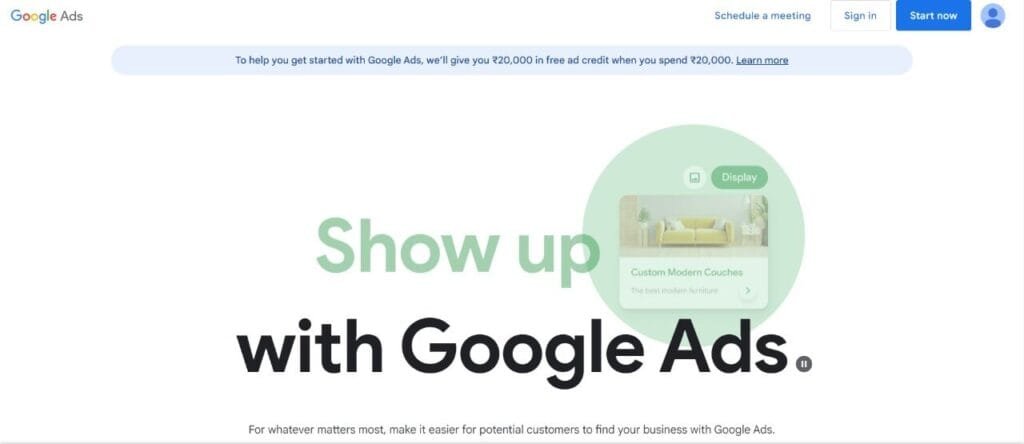
Google Ads is virtually synonymous with online advertising. As the largest and most popular PPC advertising platform, Google Ads provides businesses of all sizes with the tools they need to create successful online advertising campaigns.
Features
- Keyword Planner: Helps in identifying the best keywords for your business.
- Ad Customizers: Allows for the creation of dynamic ads that are personalized to your customers.
- Google Analytics Integration: Seamlessly integrates with Google Analytics to provide in-depth insights into your campaign performance.
Pros and Cons
Pros:
- Massive Reach: Google’s immense user base offers unparalleled reach.
- Robust Analytics: The platform provides detailed analytical data to help fine-tune your strategies.
- High Customization: Allows for highly customizable ad campaigns.
Cons:
- Complexity: The platform can be complex for beginners.
- High Competition: Being a popular platform means facing stiff competition.
Pricing
Google Ads operates on a pay-per-click (PPC) pricing model. This means you only pay when someone clicks on your ad. The cost can vary significantly based on a variety of factors including the competitiveness of your keywords.
USP (Unique Selling Proposition)
Google Ads stands tall with its unmatched reach and sophisticated targeting capabilities, offering businesses a robust platform to showcase their products and services to a global audience.
Ideal User Base
From small businesses looking to get their first customers to large enterprises aiming to maintain market dominance, Google Ads serves a broad spectrum of users. It is ideal for businesses with a considerable advertising budget and those looking to reach customers at the moment of intent.
#2. Facebook Ads Manager

Diving into the diverse ecosystem of social media advertising, Facebook Ads Manager emerges as a pivotal tool, equipping advertisers with a rich tapestry of features to reach a broad demographic. Leveraging user data meticulously, it facilitates the creation of highly targeted and personalized campaigns to resonate with your intended audience effectively.
Features
- Custom Audiences: Tailor your audience based on specific demographics, interests, and behaviors.
- Lookalike/Similar Audiences: Expand your reach by targeting users similar to your existing customer base.
- Ad Placements: Opt for automatic placements or manually select where your ads appear across Facebook’s family of apps.
Pros and Cons
Pros:
- Granular Targeting: Delve into detailed audience segmentation to reach your ideal customer.
- Visual Insights: Offers visually rich insights and reporting features to analyze campaign performance efficiently.
- Integration with Instagram: Seamlessly advertise across both Facebook and Instagram from a single platform.
Cons:
- Learning Curve: The platform can be somewhat complex for newcomers, necessitating a learning curve.
- Cost: Depending on your industry and target audience, advertising costs can quickly add up.
Pricing
Facebook Ads Manager operates on a bidding system, allowing you to control your ad spend by setting daily or lifetime budgets. The actual cost can vary based on competition and the audience you are targeting.
USP
Its ability to leverage an extensive amount of user data to create incredibly targeted ad campaigns sets Facebook Ads Manager apart, providing a landscape to foster connections with a vastly diverse audience.
Ideal User Base
Ideal for small to medium-sized businesses aiming to boost their online presence and foster community engagement. It’s also a fantastic tool for larger corporations looking to leverage detailed targeting to reach potential customers with precision.
#3. LinkedIn Campaign Manager
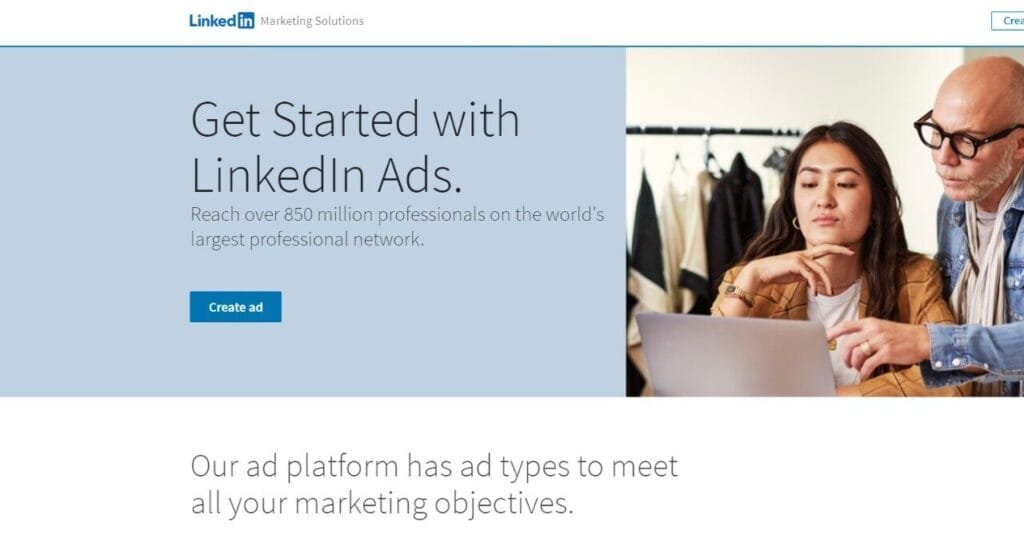
Stepping into the professional realm, LinkedIn Campaign Manager offers a unique platform to reach professionals and decision-makers across various industries. Whether you are aiming to foster B2B relationships or target professionals within a specific industry, LinkedIn’s ad platform stands as a robust choice.
Features
- Lead Generation Forms: Facilitate seamless lead collection with pre-filled forms.
- Account-Based Marketing: Target specific companies or individuals, optimizing for high-value accounts.
- LinkedIn Insight Tag: Track the effectiveness of your campaigns with detailed analytics.
Pros and Cons
Pros:
- Professional Audience: Direct access to a network of professionals and industry leaders.
- Quality Leads: High potential for generating quality leads given the professional user base.
- Varied Ad Formats: Offers a range of ad formats, including Sponsored Content, InMail, and Display Ads.
Cons:
- Higher CPC: Generally observes a higher cost-per-click compared to other platforms.
- Limited Creative Freedom: The platform offers limited scope for creative and visually appealing ads compared to other social media platforms.
Pricing
LinkedIn Campaign Manager offers a variety of bidding strategies, including CPC (cost per click), CPM (cost per thousand impressions), and CPS (cost per send). The pricing can vary based on the specific strategy chosen and the competition for your targeted audience.
USP
The platform’s stronghold is its access to a rich professional database, offering an unrivaled avenue to foster B2B relationships and target professionals with high buying power.
Ideal User Base
Tailored for B2B marketers and companies aiming to reach professionals and decision-makers in various industries. It’s a golden tool for recruitment drives and B2B product promotions.
#4. Twitter Ads
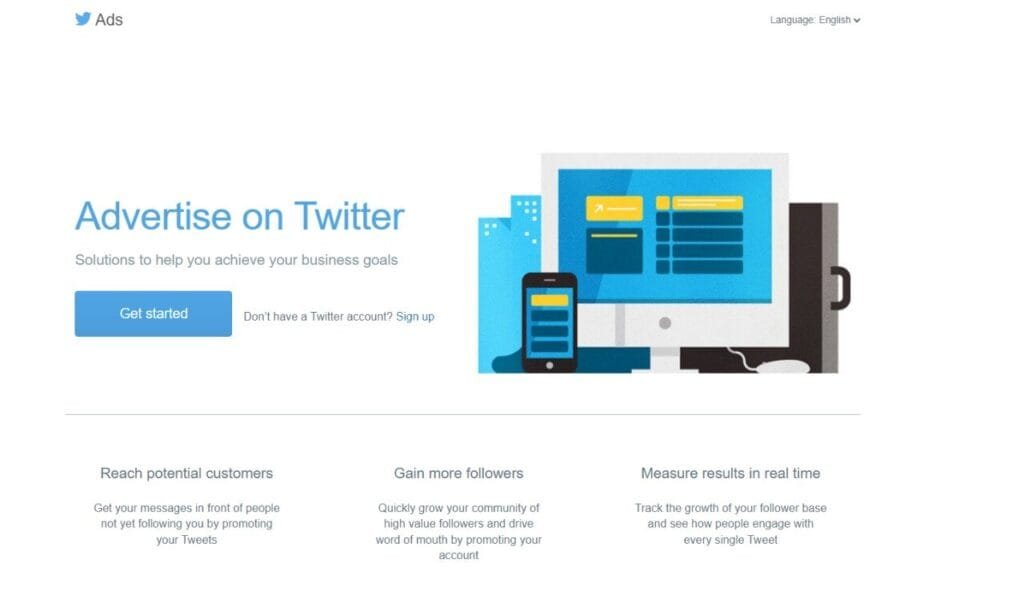
Twitter, a robust platform characterized by its real-time and conversational nature, is a hub for current events and discussions. Twitter Ads allows you to leap into these live conversations and target audiences with pinpoint precision based on their interests, behaviors, and the hashtags they follow.
Features
- Tailored Audiences: Create audiences based on a variety of criteria including device, interests, and more.
- Objective-Based Campaigns: Build campaigns centered on specific objectives such as website visits, app installs, or follower growth.
- Twitter Analytics: Gain insights into your campaign performance with detailed analytics.
Pros and Cons
Pros:
- Real-Time Engagement: Reach audiences actively engaging in real-time discussions.
- Diverse Ad Formats: Offers a range of ad formats including Promoted Tweets, Trends, and Video Ads.
Cons:
- Limited User Base: Compared to other platforms, Twitter has a smaller user base which might limit reach.
- Fast-Paced Environment: The rapidly changing content environment can sometimes bury ads quickly.
Pricing
Twitter operates on a bidding system. You can opt for automatic bids, maximum bids, or target bids depending on your strategy. Budgets can be defined on a daily or total campaign basis.
USP
Twitter stands out for its real-time engagement, giving advertisers a unique opportunity to become a part of ongoing conversations and trends, thereby fostering immediate connections with the audience.
Ideal User Base
Best suited for brands and businesses aiming to engage with audiences dynamically and in real-time, often aligning with trending topics and current events to enhance their visibility and reach.
#5. Bing Ads (Microsoft Advertising)

Microsoft Advertising, formerly known as Bing Ads, offers a significant platform to reach a diverse audience using the Bing search engine. Despite being overshadowed by Google Ads, it holds a considerable market share and often presents a less competitive and potentially more profitable avenue for advertisers.
Features
- Keyword Planner: Facilitate keyword research to enhance your ad visibility.
- Audience Segmentation: Target your ads based on demographics, location, and device type.
- LinkedIn Profile Targeting: Leverage LinkedIn data for better targeting, a feature exclusive to Microsoft Advertising.
Pros and Cons
Pros:
- Less Competitive: Fewer advertisers vying for the same keywords can mean a lower cost per click.
- Integration with LinkedIn: The integration with LinkedIn is a significant advantage, especially for B2B advertisers.
Cons:
- Smaller Audience: Bing caters to a smaller audience compared to Google, potentially limiting reach.
- Limited Ad Extensions: The platform offers fewer ad extension types compared to Google Ads.
Pricing
Similar to other platforms, it operates on a pay-per-click (PPC) model, with the cost varying based on the competition for specific keywords and the quality of your ads.
USP
What makes Microsoft Advertising a worthy contender is its exclusive integration with LinkedIn, allowing for enhanced B2B targeting and a generally less competitive environment, providing room for potentially higher ROI.
Ideal User Base
Highly beneficial for B2B advertisers, especially those looking to leverage LinkedIn data for more precise targeting. It also appeals to businesses looking for cost-effective ad solutions.
#6. Adobe Advertising Cloud
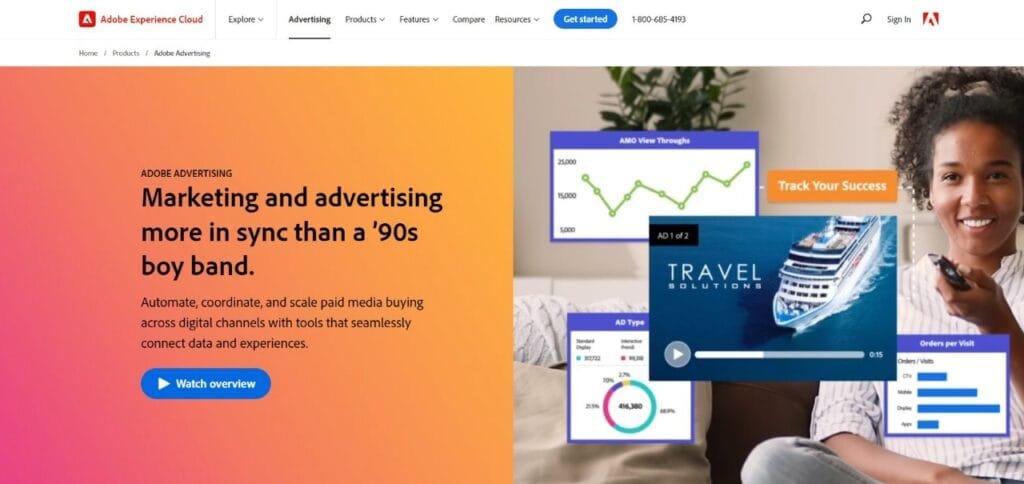
Adobe Advertising Cloud is a comprehensive ad management platform offering solutions for both search and display advertising. Built with an integrated approach, it is designed to simplify the complexities in the digital advertising landscape, giving advertisers a unified view of their campaigns across multiple channels.
Features
- Cross-Channel Advertising: Facilitates a coherent strategy across search, display, and social media platforms.
- AI-Enhanced Optimization: Leverages Adobe Sensei, Adobe’s AI and machine learning platform, for smart advertising solutions.
- Dynamic Creative Optimization (DCO): Personalize ad experiences based on real-time data and insights.
Pros and Cons
Pros:
- Comprehensive Toolset: Offers a broad range of tools for campaign management, including sophisticated targeting and tracking options.
- Integration with Adobe Stack: Seamless integration with Adobe’s suite of products for a streamlined workflow.
Cons:
- Complex User Interface: Given its extensive features, the platform can have a steep learning curve, especially for newcomers.
- Cost: Being a premium product, it comes with a high price tag.
Pricing
Adobe maintains a custom pricing strategy, wherein the costs are tailored based on individual business requirements and the scale of operations.
USP
The platform’s standout feature is its integration with the broader Adobe ecosystem, leveraging artificial intelligence and data analytics for optimized, personalized advertising experiences.
Ideal User Base
Best suited for enterprise-level organizations and marketing professionals seeking a sophisticated, integrated solution to manage large-scale advertising campaigns with a data-driven approach.
#7. Mediaocean
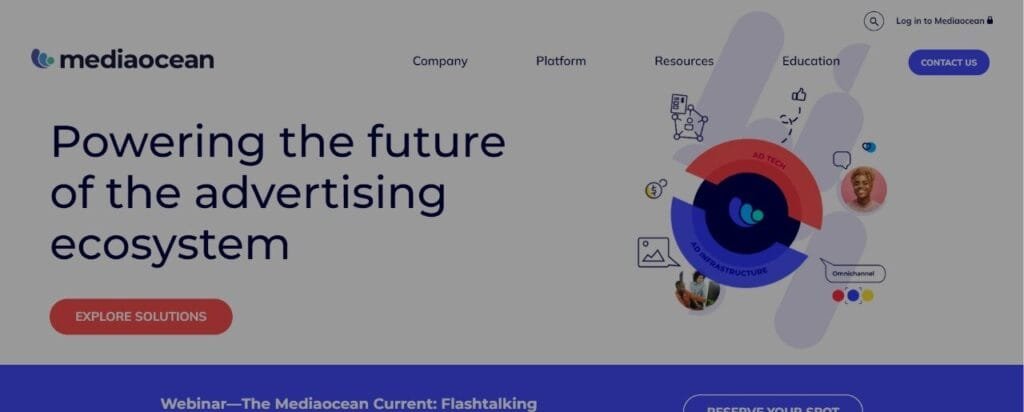
Mediaocean is a stalwart in the advertising industry, offering a platform that centralizes media planning, buying, and analytics. It caters to agencies, broadcasters, and brands, enabling them to orchestrate advertising campaigns efficiently and with transparency.
Features
- Cross-Media Workflow: Manages workflows across TV, digital, and print mediums.
- Centralized Dashboard: Offers a consolidated view of your advertising operations, facilitating easy tracking and management.
- Customized Reporting: Allows the generation of reports with insights to guide your strategy.
Pros and Cons
Pros:
- Multi-Platform Management: Simplifies the management of campaigns across various mediums from a single platform.
- Integration Capabilities: Can integrate with a wide range of third-party solutions, enhancing its functionality.
Cons:
- Learning Curve: Similar to Adobe Advertising Cloud, it demands a learning curve due to its vast features.
- Cost-Prohibitive for Small Businesses: Smaller businesses might find the platform expensive and too robust for their needs.
Pricing
Mediaocean also opts for custom pricing, focusing on delivering solutions that are aligned with the specific needs and budgets of individual businesses.
USP
Mediaocean’s strength lies in its foundational role in the advertising industry, offering a mature, robust platform with comprehensive features to manage and optimize cross-media advertising campaigns.
Ideal User Base
Ideally suited for large agencies and enterprises that require a multifaceted platform to oversee extensive advertising operations spanning various mediums.
#8. Sizmek
Sizmek, acquired by Amazon, stands as a dynamic advertising platform that infuses creativity and data analytics. The acquisition has integrated Sizmek’s profound creative solutions with Amazon’s enriched data and machine-learning functionalities.
Features
- Dynamic Creative Optimization (DCO): Offers personalization at scale, altering creative elements to suit different audiences.
- Amazon Integration: Leverage the data powerhouse of Amazon to target ads effectively and precisely.
- Cross-Device Solutions: Allows advertisers to reach audiences seamlessly across various devices.
Pros and Cons
Pros:
- Data-Driven Insights: Utilizes a rich pool of data for insights that help in sharpening the advertising strategy.
- Comprehensive Creative Tools: Empowers advertisers with tools to create striking, customized ad creatives.
Cons:
- Complex Setup: The set-up can be intricate requiring a steep learning curve.
- Potentially Higher Costs: Can be on the pricier side, especially for smaller advertisers.
Pricing
Sizmek operates with a custom pricing model, adapting to the specific needs and scale of your business operations.
USP
The unique selling point of Sizmek is its rich creative solutions combined with Amazon’s massive data repository, presenting an opportunity to build highly targeted and creative ad campaigns.
Ideal User Base
Tailored for mid to large-scale businesses looking to utilize the amalgamation of creativity and data-driven insights for innovative advertising strategies.
#9. AdRoll

AdRoll is recognized for its retargeting capabilities, aiding businesses to re-engage their potential customers. This platform has evolved to provide a range of marketing solutions including email marketing alongside its renowned ad retargeting services.
Features
- Cross-Channel Advertising: Simplifies the orchestration of campaigns across various platforms from a unified dashboard.
- AI-Driven Insights: Harness the power of AI to garner actionable insights for optimizing your campaigns.
- Flexible APIs: Allows integration with other platforms and tools to streamline your marketing efforts.
Pros and Cons
Pros:
- Easy to Use: Features an intuitive interface that is relatively easy to navigate, even for beginners.
- Retargeting Excellence: Known for its superior retargeting capabilities, helping to reclaim lost conversions.
Cons:
- Limited Advanced Features: While it is user-friendly, it may lack some advanced features found in other platforms.
- Cost: It can be a bit expensive, particularly for small businesses with limited budgets.
Pricing
AdRoll offers a variety of pricing tiers, including a free tier for small businesses with basic needs, while bespoke pricing solutions are available for larger enterprises with more extensive requirements.
USP
Its distinction lies in its retargeting expertise, enabling businesses to re-engage visitors and potentially convert lost opportunities.
Ideal User Base
Suitable for small to medium enterprises keen on leveraging retargeting strategies to boost their conversion rates.
#10. Sprinklr
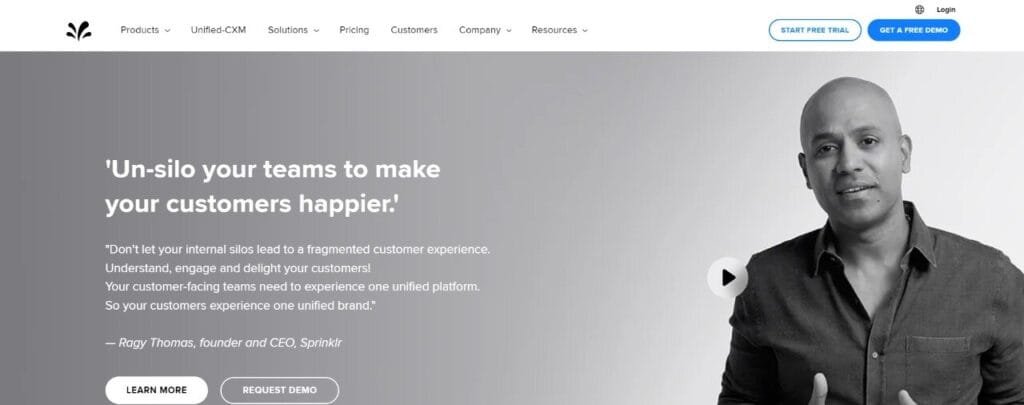
Sprinklr stands as a comprehensive Customer Experience Management (CXM) platform that goes beyond merely managing ad campaigns. It brings an all-encompassing suite that integrates social, advertising, research, and engagement into a unified framework to offer seamless customer experiences.
Features
- Unified Dashboard: A singular dashboard for tracking and managing all customer interactions and engagements across various touchpoints.
- AI-powered Insights: Utilizes artificial intelligence to provide detailed insights and facilitate data-driven decisions.
- Cross-Channel Management: Allows for a centralized strategy for managing campaigns across multiple channels efficiently.
Pros and Cons
Pros:
- All-In-One Solution: Sprinklr facilitates a broad spectrum of customer experience management functionalities, consolidating multiple tools into one.
- Advanced Analytics: Offers in-depth analytical tools that provide granular insights into customer behavior and campaign performance.
Cons:
- Complexity: Given its comprehensive nature, it can have a steep learning curve, especially for newcomers.
- Pricey: The expansive feature set comes with a higher price tag, potentially making it less accessible for smaller organizations.
Pricing
Sprinklr follows a custom pricing strategy, where the costs are tailored based on the individual needs and the scale of the business operations.
USP
The platform’s holistic approach to customer experience management, integrating advertising with other vital customer interaction points, stands as its unique selling proposition.
Ideal User Base
Sprinklr best serves large enterprises and corporations that are looking for a unified solution to manage their customer interactions and advertising strategies meticulously.
#11. Salesforce Marketing Cloud
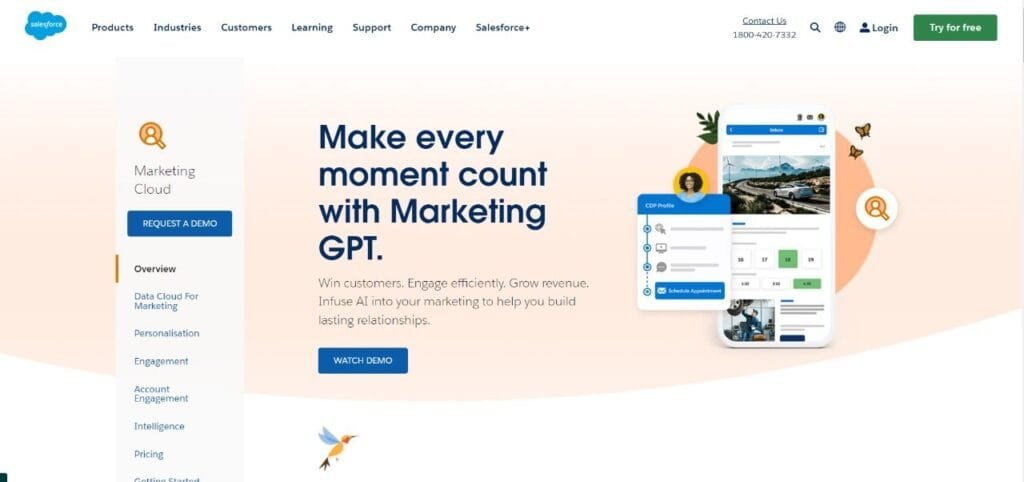
Leveraging the power of the world-renowned CRM platform, Salesforce Marketing Cloud integrates a rich set of tools designed to facilitate personalized, cross-channel marketing strategies.
Features
- Journey Builder: Facilitates the creation of personalized customer journeys based on data and insights.
- Email Studio: Advanced email marketing solutions that enable highly personalized email campaigns.
- Social Studio: Manage and govern your social media presence proficiently, taking a data-driven approach to social media marketing.
Pros and Cons
Pros:
- Integration with Salesforce Ecosystem: Seamless integration with the Salesforce ecosystem allows for a robust and comprehensive marketing strategy.
- Personalization at Scale: Tools like Journey Builder enable businesses to create highly personalized customer experiences.
Cons:
- Complex Setup: The range and depth of features necessitate a complex setup, requiring a substantial time investment.
- Cost: Given its rich feature set, the platform comes at a considerable cost, which might deter small to medium enterprises.
Pricing
Salesforce Marketing Cloud offers a customized pricing strategy, aligning with the specific requirements of the business, with various modules available for individual pricing.
USP
The standout feature is the deep integration with the Salesforce ecosystem, allowing for an enriched and data-driven marketing strategy that leverages CRM data effectively.
Ideal User Base
Suited for mid to large-scale organizations that are already part of the Salesforce ecosystem or those looking to leverage a data-rich environment for their marketing efforts.
#12. Trade Desk

The Trade Desk operates as a demand-side platform, empowering advertisers to launch campaigns across various digital mediums such as display, social media, video, and more. It is designed to foster data-driven decision-making, thereby optimizing the advertising ROI.
Features
- Cross-Device Campaigns: Enables advertisers to run campaigns seamlessly across a multitude of devices, ensuring a coherent and unified messaging.
- Data Management Platform (DMP): A comprehensive solution to manage and analyze data, deriving actionable insights for a targeted advertising strategy.
- API Integration: Facilitates integration with various data providers and other platforms to enhance the advertising ecosystem.
Pros and Cons
Pros:
- Advanced Reporting Tools: Offers a suite of advanced reporting tools to gain deep insights into the campaign’s performance.
- AI Assistance: Utilizes artificial intelligence to provide recommendations for optimizing the advertising strategy.
Cons:
- Steep Learning Curve: The platform can be somewhat complex, requiring a substantial learning curve for new users.
- Cost: The feature-rich platform comes at a premium price, potentially deterring small businesses and startups.
Pricing
Trade Desk operates with a flexible pricing model, which is structured based on the scale and complexity of the campaigns undertaken by advertisers.
USP
The platform’s power to leverage a wealth of data through its DMP and apply this to real-time bidding environments stands as its unique selling proposition, facilitating a strategic advantage in advertising campaigns.
Ideal User Base
Designed for medium to large enterprises, Trade Desk is particularly beneficial for agencies and businesses with a substantial advertising budget and those looking to exploit data-rich insights to shape their strategies.
#13. Tubemogul (Acquired by Adobe)
Now a part of the Adobe family, Tubemogul is incorporated into Adobe Advertising Cloud, offering a centralized platform to plan, buy, measure, and optimize video advertising strategies across a myriad of channels, including digital TV.
Features
- Cross-Channel Advertising: Allows advertisers to launch campaigns across various channels, including linear TV, social media, and more, from a single platform.
- Creative Management: Simplifies the process of managing creative assets and deploying them across various channels seamlessly.
- Integrated with Adobe Analytics: Offers robust analytics by integrating seamlessly with Adobe Analytics, facilitating a deep understanding of customer journeys.
Pros and Cons
Pros:
- Unified View of Advertising Strategy: Offers a consolidated view of all advertising initiatives, facilitating easy management and optimization.
- Robust Analytics: Integration with Adobe Analytics facilitates comprehensive analytical insights into campaigns.
Cons:
- Complex: The tool, being robust and feature-rich, requires a steep learning curve.
- Cost-Prohibitive for Small Businesses: Given its expansive functionality, it comes with a price tag that might be too steep for smaller businesses.
Pricing
While specific pricing details are custom-tailored, it generally aligns with the premium pricing structure of Adobe’s suite of products.
USP
The USP is its integrative approach, offering a one-stop solution for video advertising needs, supplemented by the robust analytics backbone of the Adobe ecosystem.
Ideal User Base
Large enterprises and agencies seeking a comprehensive solution for their video advertising campaigns, leveraging detailed analytics to optimize their strategies would find Tubemogul most beneficial.
#14. Semrush

Semrush is a comprehensive tool widely utilized for SEO, PPC, content marketing, and competitive research. Besides being a popular tool for SEO professionals, it’s making strides in the ad campaign management landscape, providing in-depth insights and optimization solutions for digital ad campaigns.
Features
- Keyword Research: Allows you to discover the most effective keywords for your PPC campaigns.
- Ad Builder: Facilitates the crafting of compelling ad texts using competitor insights.
- PPC Keyword Tool: Manage and optimize your keywords efficiently, and prevent keyword clashes in your PPC campaigns.
Pros and Cons
Pros:
- Rich Data Insights: Offers data-driven insights to help you make informed decisions.
- Multi-functional Platform: Aside from ad campaign management, it offers tools for SEO, content marketing, and more.
Cons:
- Can Be Overwhelming: The multitude of tools can be overwhelming for beginners.
- Cost: The more advanced features come at a premium price point, which might be a deterrent for small businesses.
Pricing
Semrush offers various pricing tiers, including Pro ($119.95/month), Guru ($229.95/month), and Business ($449.95/month), accommodating different business needs and budgets.
USP
The USP of Semrush lies in its multi-dimensional approach to digital marketing, offering tools not just for ad campaign management but extending into SEO, content marketing, and beyond, making it a versatile tool in a marketer’s toolkit.
Ideal User Base
Semrush is ideally suited for medium to large enterprises and agencies looking for a robust tool that can handle a plethora of digital marketing tasks including, but not limited to, ad campaign management.
#15. Kenshoo
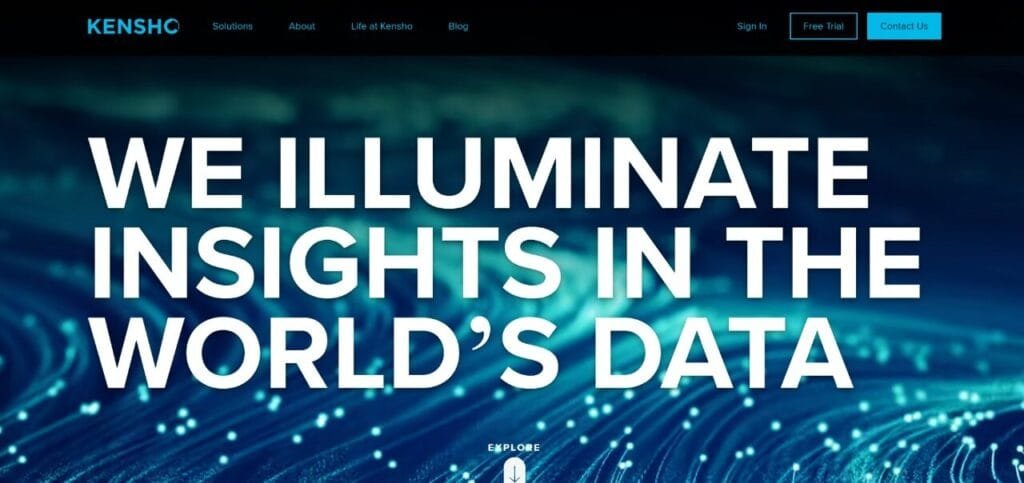
Kenshoo stands as a high-caliber marketing solution platform offering dynamic technological solutions for advertisers and agencies to automate, optimize, and analyze their campaigns with ease and precision.
Features
- Cross-Channel Advertising: Enables you to manage and optimize ads across various platforms from a centralized dashboard.
- Predictive Analytics: Leverages predictive analytics to offer actionable insights that can guide campaign optimization strategies.
- Budget Management: Facilitates efficient budget allocation across different channels to maximize ROI.
Pros and Cons
Pros:
- Advanced Analytical Tools: Offers tools to deep dive into campaign data, helping to formulate data-driven strategies.
- Automation: Facilitates automation, freeing up time for strategizing and creativity.
Cons:
- Complex Interface: Due to its comprehensive feature set, the platform can be complex, requiring a substantial learning period.
- Premium Pricing: A sophisticated solution that comes at a premium pricing level, possibly deterring small businesses.
Pricing
Kenshoo operates on a custom pricing model, where the pricing structure is curated based on the specific requirements and scale of the business.
USP
The USP for Kenshoo is its predictive analytics feature, which enables businesses to make foresighted decisions, optimizing their campaigns using predictive insights, and staying a step ahead in the game.
Ideal User Base
Suited for large enterprises and agencies with significant advertising budgets, Kenshoo caters to professionals seeking an advanced platform offering sophisticated analytical and automation tools to streamline their advertising efforts.
#16. Marin Software
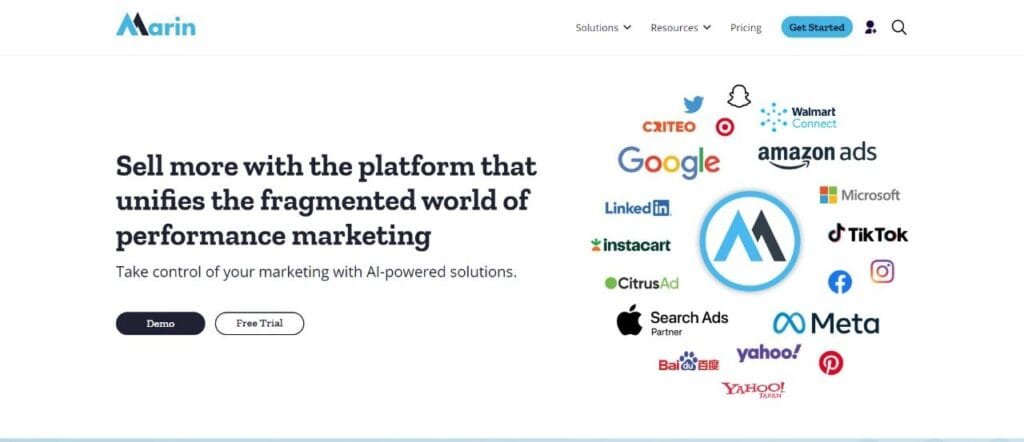
Marin Software is a revered player in the online advertising space, offering advertisers a platform that ensures their campaigns are more targeted, streamlined, and essentially, more effective. Its high-powered solutions bridge the gap between publishers and advertisers, fostering successful collaborations.
Features
- Cross-Channel Advertising: Manage campaigns across a myriad of channels including search, social, and eCommerce from a unified platform.
- Bid Management: Utilize AI-driven algorithms for optimal bid management, aiding in achieving the best ROI.
- Analytics and Reporting: Leverage advanced reporting tools to derive actionable insights from your campaign data.
Pros and Cons
Pros:
- Integration: Facilitates integration with a host of popular platforms, thereby streamlining operations.
- Automation: Incorporates smart automation features, effectively reducing manual effort in campaign management.
Cons:
- Learning Curve: The platform’s extensive feature set implies a steeper learning curve for beginners.
- Cost: The sophisticated set of features come at a premium, making it less accessible for small businesses.
Pricing
Marin Software operates on a quote-based pricing system, providing tailored solutions that align with your business size and objectives, ensuring that you pay for what you truly need.
USP
Its cross-channel advertising capability stands as its USP, allowing businesses to manage a diverse range of campaigns across multiple platforms seamlessly, thus saving time and reducing complexity.
Ideal User Base
Designed for medium to large enterprises and agencies, Marin Software is the go-to for professionals desiring a comprehensive solution that can centralize their advertising initiatives while leveraging advanced tools for optimization.
#17. Choozle

Choozle is a self-service digital advertising software that empowers agencies, marketers, and publishers with tools for building successful advertising campaigns while maintaining full control over their ad operations.
Features
- Data Management Platform: Facilitates the management of large datasets to target audiences more precisely.
- Creative Asset Library: A consolidated space to manage all your creative assets, enhancing organization and efficiency.
- Real-Time Reporting: Obtain instantaneous reports, allowing for timely adjustments to optimize campaigns.
Pros and Cons
Pros:
- Ease of Use: Despite its advanced functionalities, the platform maintains a user-friendly interface.
- Flexibility: Choozle offers a flexible platform that accommodates various advertising needs, from video to display ads.
Cons:
- Limited Advanced Features: While easy to use, it might lack some of the advanced features found in more premium solutions.
- Support: Some users have noted a desire for more responsive customer support.
Pricing
Choozle offers a straightforward pricing plan, starting at $99 per month, providing an accessible entry point for smaller businesses and startups.
USP
Choozle’s USP revolves around its self-service model, empowering users with a versatile tool that offers both simplicity and control, standing as a budget-friendly yet powerful alternative in the digital advertising space.
Ideal User Base
Choozle finds its fit with small to medium-sized agencies and businesses that prioritize having a straightforward, user-friendly platform without compromising on essential features for successful campaign management.
#18. AdEspresso

AdEspresso stands as a trusted partner for marketers aiming to optimize their advertising strategies on Facebook, Instagram, and Google Ads. With a compelling suite of features, it promotes efficiency and effectiveness in managing ad campaigns across these platforms.
Features
- Campaign Creation and Optimization: Simplifies the campaign creation process with intuitive tools and offers automatic optimization suggestions to enhance performance.
- Analytics Dashboard: Boasts a comprehensive dashboard presenting detailed analytics that facilitate informed decision-making.
- Collaboration Tools: Enables teams to work collaboratively, streamlining workflows and enhancing productivity.
Pros and Cons
Pros:
- Easy-to-Use: The platform’s user-friendly interface ensures that even novices can navigate through it effortlessly.
- Comprehensive Reporting: Offers detailed insights through analytical reports, helping you to hone your strategies over time.
Cons:
- Limited Integration: While it covers the major advertising platforms, it lacks integration with other potential platforms, somewhat limiting its versatility.
- Pricing: The pricing can be on the higher side, especially for small businesses and startups.
Pricing
AdEspresso operates on a tiered pricing strategy, with plans starting from $49 per month, going up based on the features and services included.
USP
Its standout USP is the ability to concurrently create and manage ads on Facebook, Instagram, and Google Ads from a singular platform, providing a consolidated view and control over your advertising campaigns.
Ideal User Base
AdEspresso is a match for small to medium enterprises and marketing professionals who focus their advertising efforts on Facebook, Instagram, and Google Ads, offering them a streamlined approach to campaign management.
#19. SpyFu

SpyFu opens up a world of opportunities for businesses to not only manage their ad campaigns but also to spy on their competitors. It is a tool that offers insights into the strategies employed by competitors, aiding in crafting well-informed strategies.
Features
- Competitor Keyword Research: Allows you to discover the keywords your competitors are ranking for and leveraging in their PPC campaigns.
- SEO Insights: Apart from PPC, it also furnishes you with SEO insights, guiding your organic search strategies.
- Historical Data: Provides a historical data view to analyze trends and understand market movements over time.
Pros and Cons
Pros:
- Competitive Analysis: Offers a rich set of tools for an in-depth analysis of competitors’ strategies, affording a competitive edge.
- Broad Spectrum of Features: Incorporates a range of functionalities including SEO and PPC tools, providing a versatile solution.
Cons:
- Data Accuracy: Though it aims to provide accurate data, there are instances where the data might not be 100% accurate.
- Complex Interface: The plethora of features makes the platform slightly complex, potentially daunting for new users.
Pricing
SpyFu has a transparent pricing strategy, offering plans that start at $39 per month, each tier presenting a richer set of features.
USP
The definitive USP of SpyFu lies in its competitive analysis feature, enabling businesses to stay a step ahead by understanding and leveraging insights derived from the strategies of their competitors.
Ideal User Base
SpyFu is tailor-made for businesses and marketers keen on leveraging competitive insights to shape their strategies, blending a rich feature set that aids both in SEO and PPC campaign management.
#20. Zoho Campaigns
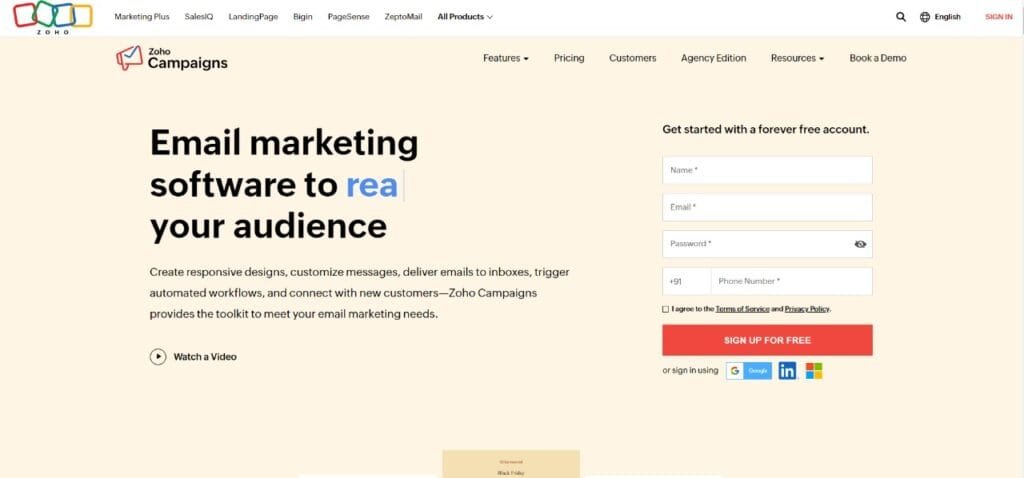
In the realm of digital marketing, Zoho Campaigns emerges as a potent tool that is meticulously designed to cater to the diverse needs of modern businesses. Leveraging this platform allows organizations to create, send, and track email campaigns that foster a more profound connection with their audience.
Features
- Automated Workflows: With Zoho Campaigns, streamline your marketing initiatives by setting up automated workflows that facilitate targeted marketing.
- Personalization: The tool empowers marketers to personalize their campaigns, thereby speaking directly to the varied segments of their audience.
- Analytics and Reporting: Zoho provides comprehensive analytics that aids in continuously optimizing the strategies based on the real-time data and insights garnered.
Pros and Cons
Pros:
- Integration with Zoho Suite: Being part of the Zoho ecosystem, it integrates seamlessly with other Zoho products, promising a unified solution for businesses.
- User-Friendly: Designed with an intuitive interface, it is user-friendly, ensuring that even individuals with limited technical know-how can operate it efficiently.
Cons:
- Limited Advanced Features: While it offers a substantial range of functionalities, it might fall short in providing some advanced features that are available in other sophisticated platforms.
- Customer Support: There have been instances where users have reported a less than satisfactory customer support experience.
Pricing
While Zoho Campaigns offers a forever free plan with basic functionalities, the paid plans begin at $5 per month, providing greater flexibility and access to advanced features as you scale up.
USP
The platform’s USP is its integrated solution, bringing together a wide array of functionalities under one umbrella. Coupled with its affordability, it becomes a go-to choice for small to medium-sized enterprises looking for a cost-effective yet powerful solution.
Ideal User Base
Startups and SMBs stand to gain the most from this tool, courtesy of its easy-to-navigate interface and integration with the Zoho suite, which can potentially simplify the orchestration of their marketing campaigns.
#21. Criteo
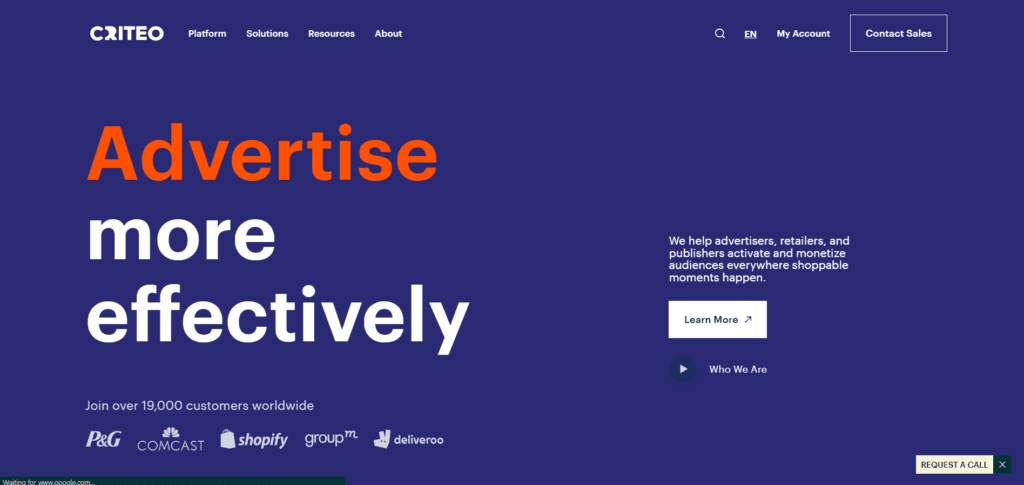
Criteo takes a dynamic approach to advertising by leveraging artificial intelligence to drive performance in campaigns. It stands as a robust platform that aids businesses in delivering personalized and engaging advertisements across a plethora of channels.
Features
- Dynamic Retargeting: The platform specializes in dynamic retargeting, helping businesses reconnect with potential customers through personalized ads.
- Predictive Analytics: Criteo leverages predictive analytics to make intelligent decisions on the bid and improve the performance of ad campaigns.
- Cross-Channel Advertising: The tool facilitates advertising across various channels, providing a unified view of the customer’s journey.
Pros and Cons
Pros:
- AI-Driven Solutions: Criteo brings the power of AI to your fingertips, offering solutions that are intelligent and future-ready.
- Highly Personalized Advertising: It allows businesses to craft advertisements that are deeply personalized, enhancing engagement and the likelihood of conversion.
Cons:
- Complexity: The advanced functionalities can introduce a level of complexity, making it a bit challenging for new users.
- Pricing: The pricing structure can be on the steeper side, especially for businesses with constrained budgets.
Pricing
Criteo operates on a CPC (Cost-Per-Click) pricing model. The pricing is quite flexible, adjusting according to your campaign’s performance and the competitive landscape.
USP
The USP of Criteo resides in its artificial intelligence capabilities which stand tall in optimizing the ad campaigns through predictive analytics and dynamic retargeting, thereby promising an enhanced ROI.
Ideal User Base
Mid to large-scale enterprises with a significant focus on leveraging data-driven insights in their advertising campaigns will find Criteo to be a valuable ally. Moreover, businesses seeking sophisticated retargeting solutions would benefit immensely from what Criteo has to offer.
Wrapping it up
In a digital landscape that is continually evolving, choosing the right ad campaign management tool is pivotal to the success of your business. As we navigated through the diverse range of tools available, we explored their unique features, pros, and cons, and pricing strategies, providing a comprehensive insight into what each brings to the table.
From startups to established enterprises, there exists a solution to meet the demands of every business type, be it leveraging AI capabilities or providing user-friendly interfaces for streamlined campaign management. Remember, the best tool will seamlessly integrate with your operations, enhancing efficiency while promising a substantial ROI. Choose wisely and steer your business towards unparalleled growth through adept ad campaign management.
Read Next:
- Creating Engaging Webinar Content: What Makes a Webinar Successful?
- How to Use Email Automation Tools: Our Take
- SEO for SaaS Pricing Pages: Conversion and Ranking Strategies
- Technical SEO for Startup Mobile Apps: App Indexing and Ranking
- Tech Startup Video SEO: Strategies for Video Visibility
- URL Canonicalization: Preventing Duplicate Content Issues
- Content Marketing for Tech Startups: Building Authority and Visibility
- How to Build Backlinks for Healthcare Websites
- User-Centric SEO for SaaS: Balancing Technology and User Experience
- Keyword Research for SaaS: Identifying Industry-Specific Terms
- On-Page SEO for Blog Posts and Long-Form Content
- Leveraging Social Sharing Buttons for SEO and Traffic
- Mobile-Friendly Pop-Ups and On-Page SEO Impact
- External Links and On-Page SEO: Quality Over Quantity
- Using Power Words and Emotional Triggers for On-Page SEO
- Select 21+ Chatbots for Lead Generation: Tested for Exact Use-Cases!





















